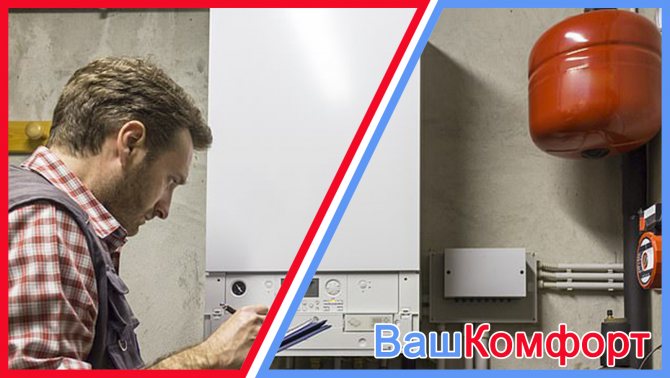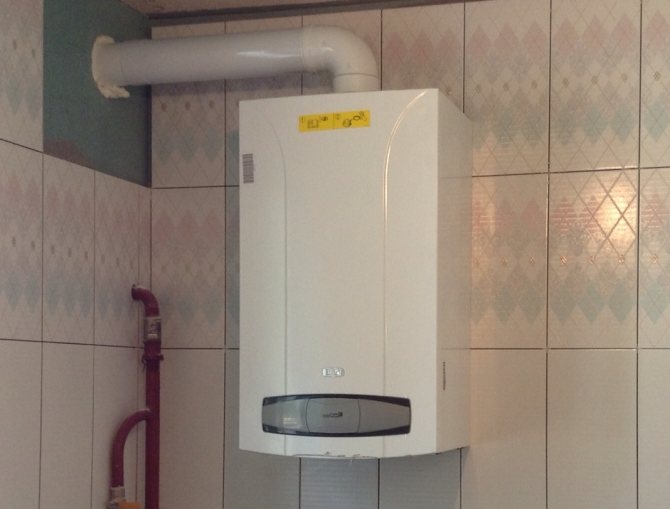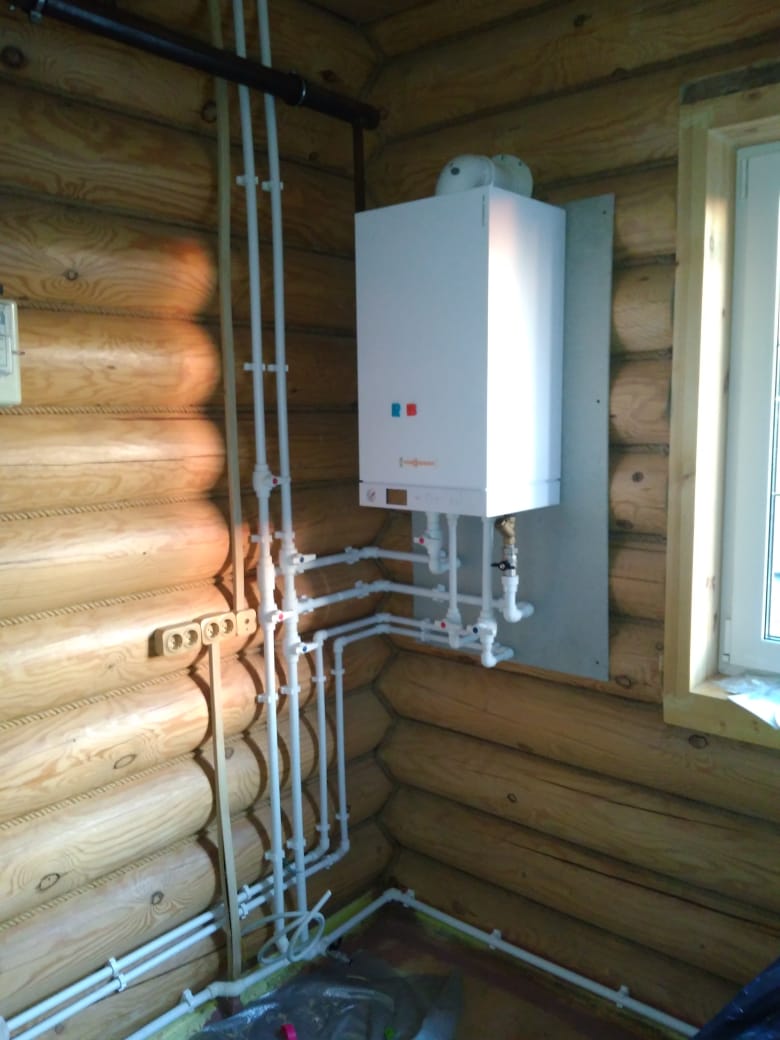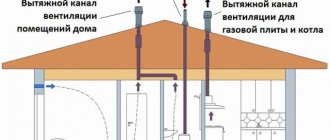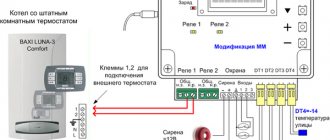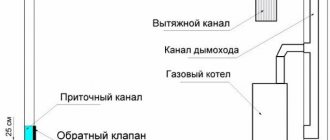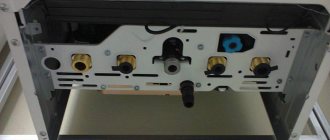If he does not dream of autonomous gas heating with hot water supply, then any householder must have seriously thought about it, both in a city apartment and in a private house. Only today it is able to reliably provide a comfortable temperature in the house cheaper than the central one. However, installing a gas boiler with your own hands is a complex, responsible business that requires a permit. Actually, it makes full sense to take on it yourself only if you have sufficient funds to purchase a double-circuit boiler with a boiler and a full set of automation, and your home according to the TU is suitable for installing a boiler.
The second case when you need a gas boiler is if you are not rich, and there is no hot water in the house at all and is not expected. In this case, you need the simplest budgetary single-circuit flow-through boiler for hot water supply, which allows you to wash dishes and take a shower. A gas boiler is more expensive than an electric boiler, but, taking into account the cost of installing a gas meter, at current rates it pays for itself in a winter and a half years, depending on the place of residence. If, again, you can put it in your apartment, and you are not afraid of going around the authorities.
Two big differences
The boilers mentioned above are the extremes of a huge variety of models of gas water heating devices. They are the ones that are available for self-installation. Any other gas heating boiler for installation requires professional work. However, every cloud has a silver lining - specialized firms undertake the preparation of the premises with the paperwork. But why only the "scissor tips" can be installed by yourself?
Simple water heater
The simplest boiler is really very simple: a gas burner, a heat exchanger - that's all. It is enough to connect water, gas to it, bring the exhaust into the chimney - and you can use it. If the papers have already been issued; otherwise, an imminent large fine.
Home boiler room
A double-circuit boiler with a boiler and full automation is so "smart" that it is as easy to install as the simplest one. Automation is important not only for simplicity: a complete system with a double thermostat and a microprocessor monitors the temperature in the house and outside, according to a given program, it reduces heating to a minimum according to sanitary standards when there is no one at home (for example, when everyone is at work). The gas consumption of such a boiler is 30-70% less than with manual or semi-automatic regulation, and the more severe the weather, the more savings.
But such a home boiler room has a serious drawback: if you find yourself in a natural disaster zone and the power supply is interrupted, the automation “stalls”, and the boiler goes into the mode of minimum heating of the room. Therefore, such a boiler requires additional consumption for a guaranteed power supply. It is not difficult to provide it yourself, see below.
Flue gas evacuation
Installation of a wall-mounted boiler implies not only its installation and connection, but also the construction of a structure for the removal of combustion products. Wall-hung boilers are divided into models with an open and a closed combustion chamber.
Water supply systems
Models with a closed combustion chamber are equipped with a coaxial chimney, made on the principle of a pipe in a pipe. The inner pipe removes flue gases, the outer pipe is used to take in atmospheric air for combustion. Such a pipe can be taken out of the wall of the house, forgetting about the cumbersome and expensive construction of the chimney above the ridge of the building's roof. Boilers with an open combustion chamber take air from the room and require a connection to a standard chimney.
- Heating repair
- Cottage heating
- House heating
- Water supply at home
- Dacha water supply
Where can and where not to put a gas boiler
The rules for installing a gas boiler provide the following requirements for installing a HEATING boiler, regardless of whether it also provides DHW or not:
- The boiler must be installed in a separate room - a furnace (boiler room) with an area of at least 4 sq. m., ceiling height of at least 2.5 m. The rules also indicate that the volume of the room must be at least 8 cubic meters. Based on this, you can find indications of the permissibility of a ceiling of 2 m. This is incorrect. 8 cubes is the minimum free volume.
- The furnace must have an opening window, and the width of the door (not the doorway) must be at least 0.8 m.
- Furnishing the furnace with combustible materials, the presence of a false ceiling or raised floor in it is unacceptable.
- The combustion room must be provided with an air flow through a through, unclosed air duct with a cross section of at least 8 sq. Cm. for 1 kW of boiler power.
Note: 8 free cubes - with a boiler power up to 30 kW. For power from 31 to 60 kW - 13.5 cubic meters; for power from 61 to 200 kW 15 cubic meters. For boilers with a closed combustion chamber, the volume of the combustion chamber is not standardized, but the dimensions must still be observed.
For any boilers, including wall-mounted hot water boilers, general standards must also be met:
- The boiler exhaust must go into a separate flue (often incorrectly called a chimney); the use of ventilation ducts for this is unacceptable - hazardous combustion products can get into neighbors or other rooms.
- The length of the horizontal part of the flue must not exceed 3 m within the combustion chamber and have no more than 3 angles of rotation.
- The outlet of the flue must be vertical and raised above the ridge of the roof or the highest point of the gable on a flat roof by at least 1 m.
- Since the combustion products form chemically aggressive substances during cooling, the chimney must be made of thermo- and chemically resistant solid materials. The use of laminated materials, eg. asbestos-cement pipes, it is permissible at a distance of at least 5 m from the cut of the boiler exhaust pipe.
When installing a wall-mounted hot-water gas boiler in the kitchen, additional conditions must be met:
- The height of the boiler suspension along the edge of the lowest branch pipe is not lower than the top of the sink spout, but not less than 800 mm from the floor.
- The space under the boiler must be free.
- A durable, fireproof 1x1 m sheet of metal must be laid on the floor under the boiler. Gas workers and firefighters do not recognize the strength of asbestos cement - it wears out, and SES prohibits having anything containing asbestos in the house.
- The room should not have cavities in which combustion products or an explosive gas mixture can accumulate.

If the boiler is used for heating, then gas workers (who, by the way, are not very friendly with the heating network - it always owes them for gas) will also check the state of the heating system in the apartment / house:
- The slope of the horizontal pipe sections must be positive, but not more than 5 mm per running meter of water flow.
- An expansion tank and an air valve must be installed at the highest point in the system. It is useless to convince that you will buy a "cool" boiler, in which everything is provided: rules are rules.
- The state of the heating system must allow its pressure testing under a pressure of 1.8 atm.
The requirements, as we see, are tough, but justified - gas is gas. Therefore, it is better not to think about a gas boiler, even a hot water boiler, if:
- You live in a block Khrushchev or other apartment building without a main gas duct.
- If you have a false ceiling in your kitchen, which you do not want to remove, or a capital mezzanine. On a mezzanine with a bottom made of wood or fiberboard, which, in principle, can be removed, and then there will be no mezzanine, gas workers turn a blind eye.
- If your apartment is not privatized, you can rely only on a hot water boiler: the allocation of a room for a furnace means redevelopment, which can only be done by the owner.
In all other cases, you can put a hot water boiler in the apartment; a heating wall is possible, and a floor one is very problematic.
In a private house, any boiler can be installed: the rules do not require that the furnace be located directly in the house. If you make an extension to the house outside under the furnace, then the authorities will only have fewer reasons for nagging.In it, you can put a high-power floor-standing gas boiler to heat not only a mansion, but also office premises.
For private housing of the middle class, the optimal solution is a wall-mounted boiler; it is not required for it, as for a floor one, to arrange a brick or concrete pallet with sides of half a meter. The installation of a wall-mounted gas boiler in a private house also does without technical and organizational difficulties: a fireproof closet for a furnace can always be fenced off, at least in the attic.
Rules for installing a wall-mounted gas heating boiler
Preparatory work for the installation of a wall-mounted gas appliance begins at the stage of its acquisition. It is imperative to make sure that the equipment is complete and that the fasteners are present. If they are absent, they must be purchased (read: "Installation of wall-mounted gas heating boilers - connection diagram for examples").
When buying a gas boiler, you need to make sure that the products are certified, otherwise there will be difficulties in registering the device. You should also check the serial number and parameters of the unit indicated in the documents attached to it with those on the inner surface of the door.
When gas heating boilers are installed, the installation begins with flushing all the internal pipes, for which the transport plugs are removed and water is passed through the device under low pressure. The fact is that during the assembly process at the factory, debris could get into the tubes, which must be removed without fail.
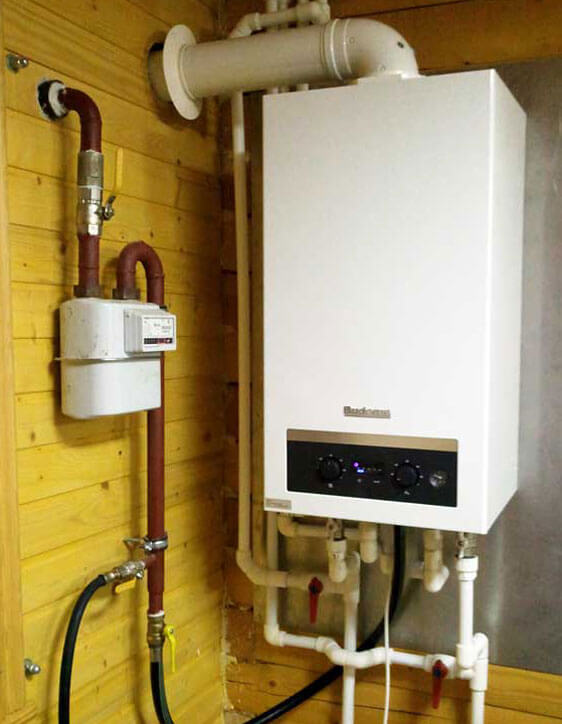

The surface of the wall where the boiler will be located must be made of non-combustible materials. If this is not the case, then a 3 mm layer of heat resistant coating should be placed on the wall. The rules for installing a gas boiler assume that the device is placed at a distance of at least 45 millimeters from the wall. See also: "What rules for installing a gas boiler in a private house must be followed."
After that, they proceed to the installation of the heating unit: the sequence of actions is as follows:
- At a height of 80 to 160 centimeters from the floor covering, mounting strips are attached, and a boiler is attached to them. Its location is checked using a level. The technical conditions for the installation of a gas boiler regulate that it must be placed at a distance of at least 20 centimeters from other devices operating on gas or electricity. There should be no flammable materials in the immediate vicinity.
- A filter should be installed on the inlet pipe to prevent clogging of the heat exchanger. On both sides of it, shut-off valves are mounted. As a result, the filter can be removed and cleaned without draining the water from the system.
- Then, the chimney of the gas boiler is installed and the presence of draft is confirmed. By the way, most modern suspended units are those that do not have a chimney. The combustion products are removed by means of a small fan, since no strong draft is required in the chimney.
- After that, the gas line is connected. This stage is performed only by certified specialists.
- The installation of a gas boiler in the kitchen or in a room specially designated for this appliance is completed by connecting the appliance to the mains. If the operation of the heating unit depends on electricity, the power circuit is equipped with an overheating and short circuit protection circuit breaker.
About flue
The cross-sectional area of the house gas duct for it depends on the required boiler power (see below). At any power, the diameter of the flue must be at least 110 mm and at least the diameter of the exhaust pipe. The dependence of the flue diameter on the boiler power is as follows:
- up to 24 kW - 120 mm.
- 30 kW - 130 mm.
- 40 kW - 170 mm.
- 60 kW - 190 mm
- 80 kW - 220 mm.
- 100 kW - 230 mm.
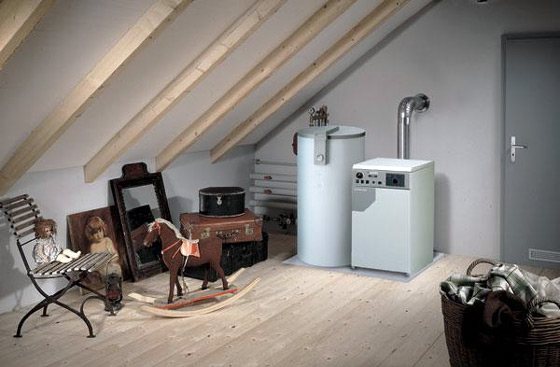

Boiler selection
Power
It is obvious that the boiler output must be sufficient.But it should not be excessive, especially if the heat exchanger is cast iron. Drops of condensate from the flue will crack the hot cast iron. There is another dangerous effect: the dew point temperature of the exhaust gases is about 56 degrees Celsius. If the water temperature in the heating return is lower, acid condensation may form in the combustion chamber. What does this have to do with excess capacity? A too powerful boiler will quickly warm up the system and go into standby mode until it cools down. The thermal inertia of a powerful heat exchanger is great, and while it warms up again, acid dew may fall out.
With a properly selected boiler power, the temperature in the combustion chamber will be 80-90 degrees. The permissible difference in power is large enough, but if a 60 kW boiler is installed in a medium-sized private house, then acid rain from the inside will quickly disable it.
The required boiler power for a particular room is determined by a heat engineering calculation. It is easier for residents of high-rise buildings: the data is in the DEZ, the technical inventory bureau or the owner. In any case, you can use the approximate data by calculating an intermediate value for yourself. The maximum power values are given for cases with a minimum outside temperature of -25 / -40 degrees:
- One room apartment on the middle floors - 8/14 kW.
- Corner apartment 60 sq.m. total area on the top floor of the block Khrushchev - 20/28 kW.
- Private house 100 sq.m total - 24/38 kW.
Boiler
The purpose of the boiler is to accumulate hot water for domestic needs. If you look at the instructions for the boiler, then the power there will be indicated through a fraction, for example - 10/22 kW. The first number is the heating capacity for average conditions; it determines the gas consumption by 80%. The second power, maximum - for fast heating of domestic water.
If the boiler is empty, the boiler temporarily stops heating the heating (it will not have time to cool down) and heats the domestic water at the maximum. In this case, the gas consumption is, of course, the maximum. If you take a little water from the boiler, then it will be heated in operating mode, without force majeure. Based on this, the capabilities of the boiler can be judged by its capacity:
- 2-10 l - wash your hands and wash the dishes.
- 30-50 liters - take a quick shower.
- 100 l - wash thoroughly in the shower.
- 150 liters or more - you can take a bath and connect a washing machine to the hot water supply.
Note: if you already have a household electric boiler, it is advisable to leave it by turning off its automatic machine. It will make a good hot water accumulator, and in case of problems with the gas boiler, you can turn it on.
Video: expert opinion on the choice of gas boilers
Installation of boilers in individual houses
The method of placing a heating boiler in a residential building depends on its design and can be floor-standing or wall-mounted. It should be noted that floor-standing models in most cases exceed hinged heat sources in terms of thermal power.
In addition, the freer circulation of the coolant in such devices allows their installation for operation in autonomous heating systems with natural circulation.
Installation of floor-standing boilers in a separate combustion room
If it is necessary to install a heat source with a power of more than 32 kW, gas boilers with floor installation are chosen, since the thermal performance of serial mounted models does not exceed the named value. The developed standard furnace schemes for private houses provide for the presence of:
- expansion tank;
- domestic hot water heater;
- capacitive or high-speed separator;
- distribution comb;
- at least two circulation pumps.
In addition, it is required to install emergency relief lines and safety valves that are triggered when the pressure in the pipelines rises.
Boiler installation work begins with the preparation of brick or concrete foundations not only for it, but also for all tanks, which, after filling with water, will become quite heavy. After that, it is necessary to assemble the distribution manifolds and pumping units with shut-off valves, and fix them on the wall according to the design scheme.
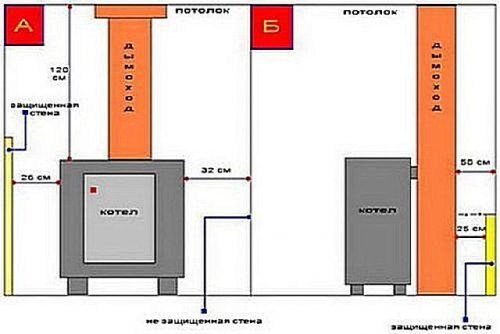

Boiler documents
Let's say you have equipped a furnace in compliance with all requirements. Buying a boiler? Still early. First of all, check if the old papers are not lost on gas, and take them out into the light of day:
- Gas supply contract, if the boiler is heating. Sub-consumers can only install hot water boilers.
- All documents for the gas meter. Any boiler cannot be installed without a meter. If it is not there yet, there is nothing to be done, you need to set and arrange, but this is another topic.
Now you can buy a boiler. But, having bought, it is too early to install:
- In the BTI, you need to make changes to the registration certificate at home. For privatized apartments - through the organization operating the building. The new plan should include a closet under the boiler, and clearly marked: "Furnace" or "Boiler room".
- Submit an application to the gas service for the project and technical specifications. As part of the required documents and a technical passport for the boiler, so it must already be purchased.
- Install the boiler (see next section), except for the gas system. This can be done while the gas workers are preparing the project, if the premises are approved.
- Call a specialist to make a gas connection.
- Submit an application to gas workers for commissioning.
- Wait for the arrival of the gas service engineer, he will check everything, draw up a conclusion on suitability and give permission to open the gas shut-off valve to the boiler.
Note: gas workers are not allowed to give permission to individuals to work on gas equipment. Therefore, to connect the gas to the boiler, you will have to call a specialist or then "resolve the issue" with the inspector during commissioning. As a rule, the former is cheaper.
Boiler installation
Adjoining the boiler body close to any of the walls is unacceptable, therefore, remodel the fasteners of wall-mounted boilers, sink the boiler into a niche, etc. it is impossible. After installing the boiler in place, its piping is done - connecting three systems: gas, hydraulic and electrical. The gas piping should, as indicated, be done by a gas specialist, and last of all, when everything else is already connected.


Gas boiler hydraulic piping diagram
Electrical and hydraulic piping can be done independently. Here the main guiding document is the instruction for the boiler. A typical boiler hydraulic connection diagram is shown in the figure. For any boiler, the following conditions must be met exactly:
- Water and hot gases in the boiler heat exchanger must flow in a counterflow, otherwise it can simply explode with any automation. Therefore, it is extremely important not to confuse, through negligence or for the sake of ease of installation, cold and hot pipes. After hydraulic piping, inspect the entire system carefully again, then rest for an hour, and inspect again.
- If antifreeze has been poured into the heating system, drain it completely and flush the system twice with clean water. The admixture of antifreeze in the water entering the heat exchanger is also explosive.
- Do not neglect "mud collectors" - filters for coarse water purification. They should be located at the lowest points in the system. The accumulation of dirt between the thin fins of the heat exchanger also creates a hazardous situation, not to mention the excessive gas consumption. At the beginning and at the end of the heating season, drain the sludge through the mud collectors, check their condition and, if necessary, flush the system.
- If the boiler has a built-in expansion tank and a de-airing system, remove the old expansion tank, and close the old air valve tightly, having checked its condition beforehand: air leaks will also create a dangerous situation.

